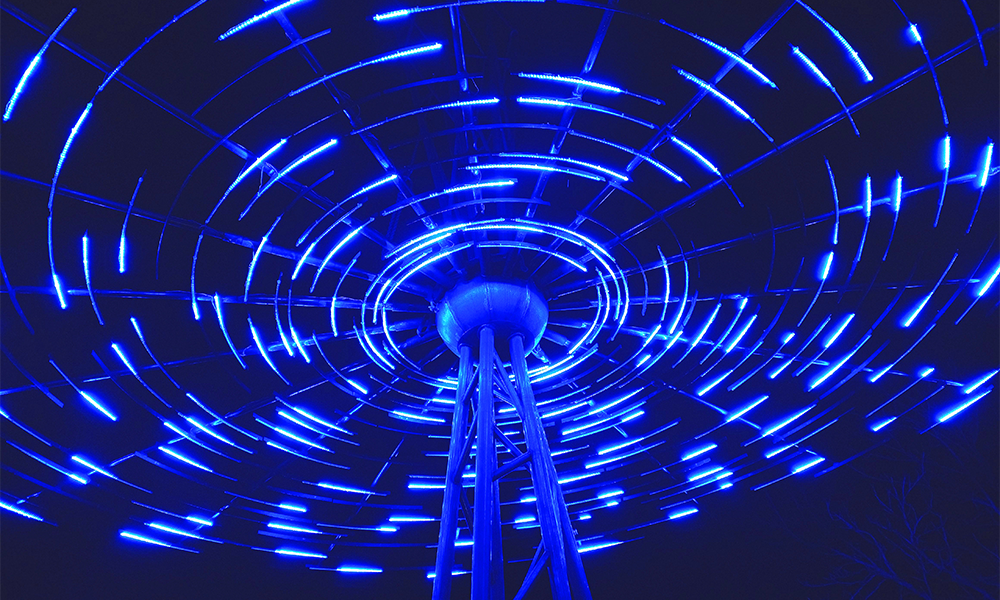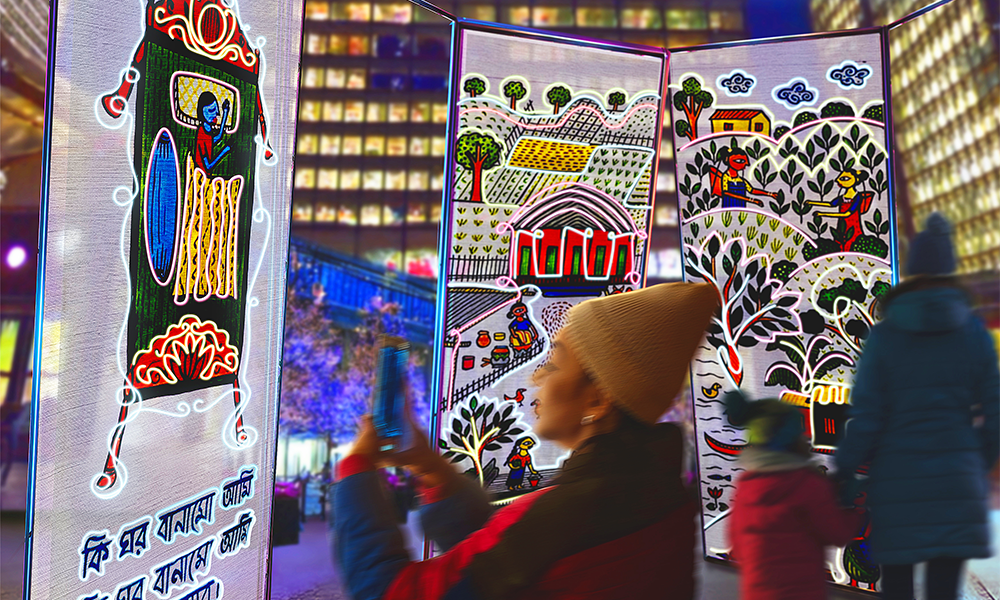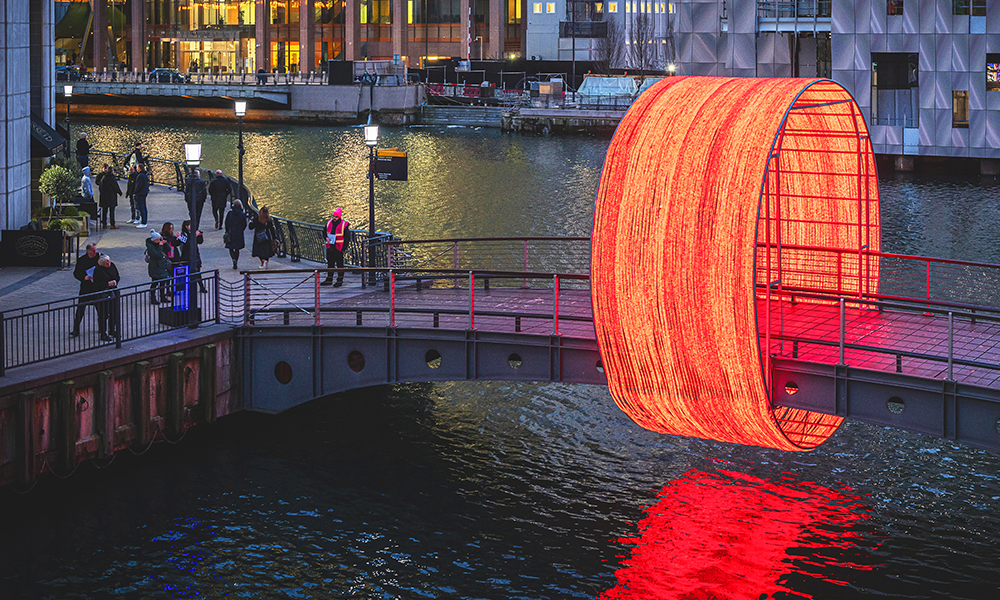We get tips for the festival and take a deeper look at Emergency Exit Arts’ Stitching Light installation

Subscribe to our free Wharf Whispers newsletter here
January 21, 2025 is set to see the Canary Wharf Winter Lights festival return for 12 days of illumination, filling the estate with installations for a ninth edition.
For 2025, there will be a total of 12 temporary artworks on show, combining with seven permanent pieces making a total of 19 for visitors to discover.
But when the electrons start flowing to create all those photons for our eager eyeballs to absorb, one work in particular will be shining for east London and beyond.
Commissioned by Canary Wharf Group for the festival, Stitching Light is the result of collaboration between Emergency Exit Arts (EEA), artist Ruhul Abdin in Bangladesh and Oitiji-jo.
The piece draws on the stories and experiences of British Bangladeshi women who migrated to the UK early in their adult lives.
The resulting installation will be placed at Wren Landing during Winter Lights.
the genesis of Stitching Light
“We work with hundreds of different arts practitioners and what we’ve noticed with lights festivals is that the pieces featured are often very beautiful but there may not have been participation or much of a story behind them,” said Daniel Bernstein, CEO of EEA.
“Often the artists involved in light pieces are white men, so we’re always interested in bringing in different stories and greater depth to the work.”
With Ruhul in place as creative director, work on the project began with workshops run by freelance artist Shama Kun via the Oitiji-jo Collective at Republic in Blackwall.
running the workshops
“I run a lot of sessions with the Bangladeshi community, dealing with crafts, so I’d bonded with the women locally,” said Shama.
“With this project, I realised that we had never looked into the stories of the mums and aunties.
“So we provided a safe space and invited them to contribute.
“We tried to be relaxed about it, having tea, a conversation, so the process started with that.
“We asked them to bring memorable objects, so the stories could start from there, then we drew maps, starting with their childhoods and what the transition to Britain was like.
“One thing that came out was they described their lifestyles as a rainbow.
“They said that their lives started as colourful, really amazing, and then their transition to here was a rollercoaster, not knowing people – it was a struggle.
“In the community we’ve relied on these women but haven’t looked in depth into their stories.
“They opened up for this project because they felt safe.
“They came here very vulnerable, without any support and talked about many things including being the victims of racism – that trauma is still there.
“After the workshops I realised I am here today because of their sacrifices, that we are resilient because of their resilience.
“This was a platform for them to tell their stories and I hope there will be more spaces like this for them to do that in future.
“We recorded the conversations – lots of discussions about their favourite foods, colours, smells and more – before turning over the material to Ruhul.”

a piece for Canary Wharf Winter Lights
That work formed the basis of the finished piece – a series of three metre-high fabric panels with illuminated thread stitched into the design which will be displayed in a 3D structure allowing visitors to walk through and around the work.
“What you see are very beautiful, soft, subtle layers of the stories we were told,” said Ruhul.
“The panels are stitched and painted with a sound piece to accompany them reflecting some of the women’s thoughts and stories, the songs they sang and the songs they like.
“We worked with a folk artist to translate some of these ideas into Bangla-inspired paintings which would then be taken back to London – it was back-and-forth between Bangladesh and the UK.
“For me it’s important to have this piece on display in Canary Wharf because Tower Hamlets has hosted so many generations of Bangladeshis now – there is a need to be visible beyond the brown person walking our streets.
“There is also the multicultural aspect of London and this is a nice way to celebrate something without it being a research project or an academic exercise.
“We’re creating art together and it’s a beautiful way of highlighting who the women were and are, and the potential of art to begin to make some of these nuanced changes as Canary Wharf itself continues to evolve.”
representation at Canary Wharf Winter Lights
Daniel added: “Being part of Winter Lights its really important for the participants in the workshops and for the people making the work.
“From an audience perspective, there are going to be layers.
“Perhaps half of the visitors will walk through the piece and be impressed by the lights and the images – but they may not understand the Bangla script on the panels, although there will be a panel explaining the work.
“Hopefully, anyone from a Bangladeshi background will come to the piece and see themselves represented. It’s quite subtle.”
Shama said one of the most important parts of the project was to celebrate the local community.
“There is so much out there for us to learn from our past generations,” she said.
“These women might not boast that they have done this or that, but they have silently achieved things and we need to carry their flag.”
Ruhul added: “One of the biggest takeaways is the potential to hope that this work will continue.
“I have spoken to a colleague who is a Bangladeshi migrant elsewhere and they said how crucial it was to understand things from the elders.
“It is important to see that Stitching Light is inspiring, so the next generation want to understand more about who they are, where their families have come from – especially those of us who are not white British, but it’s vital for everyone.”
Emergency Exit Arts was founded in 1980 as an artists’ collective aspiring to make a positive difference to people’s lives – especially those who have suffered discrimination or economic exclusion.
It has been based in Greenwich for more than 35 years.

top tips for the festival
Canary Wharf Winter Lights is set for a blockbuster turn, drawing hundreds of thousands of people to the estate over its 12-day run.
We sat down with Canary Wharf Group’s associate curator of Arts And Events, Lowri Harries, and Arts And Events manager, Camilla McGregor, to get a few tips on what to look out for…
LH: Vendel And De Wolf are back in Westferry Circus with Error – an upside down pylon with a tornado of lights around it, 13 metres in the air.
Last year they created a piece called Sign, which looked like a huge fire.
They specialise in taking mass produced materials and using them to depict natural phenomena.
For Error, they’ve used technology to give the piece a random element, reflecting the idea that both nature and machines can go wrong.
Don’t Miss Out: Make sure your table is booked for the festival
CM:I’m looking forward to seeing Portal in the flesh. It will be a 13 metre-high mirrored doorway in Union Square that visitors can walk through.
I think the scale and magnitude of it will make people feel quite small in comparison and also acts as a piece to frame the Wharf with great sight lines though it to other parts of the estate.
It’s one of the largest pieces we’ve ever hosted and it’s definitely something new.
LH: I’m also especially looking forward to seeing Aj Vana Be by Benedikt Tola – it’s essentially a stack of 32 reclaimed bathtubs that have been taken from socialist-era residential buildings by the Czech artist.
It draws attention to the scarcity of water.
Even though washing is an an everyday act, it draws attention to that privilege.
CM: Putting Winter Lights on is essentially a year-long process.
A month after it’s finished, we begin work on the next edition, sending out an open call for artists and organisations to contribute.
Then we start looking for work to feature.
LH: It feels really lovely when we see people enjoying the installations.
I think visitors really treasure a free event in January with people coming from the local community and from further afield.
As with Stitching Light, we’re looking to work with and take inspiration from the local community more and more – we want everyone to feel comfortable coming here.
This is a place for everyone.

key details: Canary Wharf Winter Lights
Canary Wharf Winter Lights is set to run daily from January 21-February 1, 2025, 5pm-10pm, with 19 installations to discover across the estate.
The festival is free to visit.
Find full details of Winter Lights here and plan your visit with the official event map here
Read more: How Dez Amore has smashed burgers and pasta together under one brand



